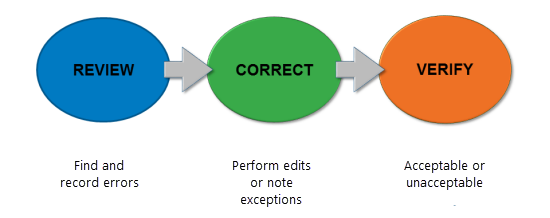To produce high-quality information products and perform accurate spatial analysis, source data must meet high standards and be well maintained. ArcGIS Data Reviewer enables management of data in support of data production and analysis by providing a system for automating and simplifying data quality control that can improve data integrity.
Data Reviewer provides a comprehensive set of quality control (QC) capabilities that enable an efficient and consistent data review process. This includes workflows that support both automated and semiautomated analysis of data to detect errors. Errors detected during data review are stored to facilitate corrective workflows and data quality reporting.
Automated data review
Automated data review evaluates a feature's quality without human intervention. Data Reviewer includes a library of configurable checks that allow you to validate data based on your quality requirements. Data Reviewer checks are designed to assess various aspects of a feature’s quality, including its attribution, integrity, or spatial relationship to other features. Data Reviewer automated checks are configurable and do not require specialized programming skills to implement. In many cases, GIS professionals with a good understanding of their data’s quality requirements can implement automated review with minimal training.
Validation-enabled services allow clients to implement automated data review using attribute rules created with Data Reviewer checks. These services use ArcGIS Server to carry out automated review using an organization's on-premises or cloud-hosted infrastructure. In a production environment, automated review can be triggered on an as-needed basis to support ad hoc assessment of data quality as a component of a data management workflow.
To learn more about using Data Reviewer to automate workflows to assess data quality, refer to the following help topics:
Semiautomated data review
Not all errors in your data can be detected using automated methods. Semiautomated review assesses data quality using workflows guided by human interaction and input. Visual review is a common form of semiautomated review that assesses quality in ways that automated data review cannot. This includes identifying missing, misplaced, or miscoded features and other issues that automated checks may not detect.
To learn more about using Data Reviewer to implement semiautomated workflows to assess data quality, refer to the following help topics:
Error management
Data Reviewer enables error management through correction and verification. These capabilities improve data quality by identifying the source, location, and cause of errors. Error management workflows reduce costs and eliminate duplicated work by providing insight into how the error was detected, who corrected it, and whether the correction was verified.
The data review process tracks errors through a defined life cycle process, consisting of three phases: Review, Correction, and Verification.

Each phase contains one or more status values that describe the actions taken as the error progresses from one phase to another.
In attribute rule-based workflows, the geodatabase stores errors within a series of system-maintained tables. Errors are accessed using the Error Inspector pane, which provides tools for reporting, navigation, and selection of features that facilitate error correction.
To learn more about Data Reviewer error management workflows, refer to the following help topics: